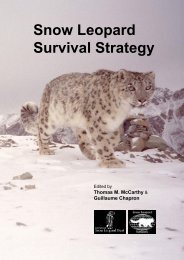Estimating the population density of Mongolian gazelles Procapra ...
Estimating the population density of Mongolian gazelles Procapra ...
Estimating the population density of Mongolian gazelles Procapra ...
Create successful ePaper yourself
Turn your PDF publications into a flip-book with our unique Google optimized e-Paper software.
168<br />
K. A. Olson et al.<br />
data is probably warranted; i.e., decreases in <strong>density</strong><br />
estimates should be treated as such unless <strong>the</strong>re is<br />
accurate information to accept ano<strong>the</strong>r trend.<br />
Our estimate <strong>of</strong> 800,000–900,000 <strong>gazelles</strong> in a portion<br />
<strong>of</strong> <strong>the</strong> entire gazelle range indicates that <strong>the</strong> <strong>population</strong><br />
is still relatively large. Ecologically this is important<br />
because <strong>gazelles</strong> are prey, for example, for wolves,<br />
eagles, and scavenging vultures on <strong>the</strong> steppe. Thus,<br />
a severe decline in <strong>the</strong> gazelle <strong>population</strong> could result<br />
in a cascade <strong>of</strong> ecological effects in <strong>the</strong> eastern steppe.<br />
Additionally, severe declines in <strong>the</strong> gazelle <strong>population</strong><br />
would probably have a negative impact on traditional<br />
subsistence hunting practices.<br />
Currently, <strong>the</strong>re is no regular monitoring programme<br />
<strong>of</strong> <strong>the</strong> <strong>Mongolian</strong> gazelle <strong>population</strong> with an established<br />
protocol. In <strong>the</strong> absence <strong>of</strong> such a programme, setting <strong>of</strong><br />
hunting quotas for what may appear to be a sustainable<br />
harvest (i.e. one that does not cause a decline in <strong>the</strong> <strong>population</strong><br />
and promotes conservation) may simply be an<br />
example <strong>of</strong> unintended overkill (Murray, 2003; Zahler<br />
et al., 2004). More simply, if <strong>the</strong> <strong>population</strong> size is<br />
unknown but <strong>the</strong>re is incentive to harvest because <strong>of</strong><br />
market forces, it is likely that too many will be killed.<br />
Disease outbreaks are known to cause sudden declines<br />
in <strong>Mongolian</strong> <strong>gazelles</strong>. Schaller & Lhagvasuren (1998)<br />
described <strong>the</strong> loss <strong>of</strong> two year-classes, in addition to<br />
a large proportion <strong>of</strong> adults, to footrot Fusobacterum<br />
necr<strong>of</strong>orum in autumn 1998. It is not clear what effect this<br />
had on <strong>population</strong> densities because <strong>of</strong> <strong>the</strong> absence <strong>of</strong><br />
monitoring. Heavy poaching, in addition to years <strong>of</strong> high<br />
natural mortality, could cause a severe decrease in <strong>the</strong><br />
<strong>population</strong>, and this could go unnoticed if <strong>the</strong>re is no<br />
regular monitoring.<br />
Monitoring <strong>of</strong> overall numbers alone, however, is<br />
unlikely to be sufficient to conserve <strong>gazelles</strong>, as seen<br />
from studies <strong>of</strong> o<strong>the</strong>r species. Saiga antelope Saiga tatarica<br />
have been relatively well monitored for over 20 years,<br />
but <strong>the</strong> last few monitoring efforts detected a precipitous<br />
and potentially unrecoverable crash in <strong>the</strong> <strong>population</strong><br />
(because <strong>of</strong> highly skewed sex ratios due to excessive<br />
hunting <strong>of</strong> males; Milner-Gulland et al., 2003). If saiga<br />
over-harvest had been monitored and sufficient management<br />
efforts had been instituted earlier, however,<br />
successful conservation intervention may have occurred<br />
before <strong>the</strong> <strong>population</strong> collapse instead <strong>of</strong> after it. Tibetan<br />
antelope Pantholops hodgsonii, or chiru, had potential to<br />
provide a valuable sustainable source <strong>of</strong> income for<br />
residents <strong>of</strong> <strong>the</strong> Tibetan plateau from live-combing (vs<br />
recovery from dead animals) and selling <strong>the</strong> animals’ fine<br />
wool. But <strong>the</strong> once estimated <strong>population</strong> <strong>of</strong> 1,000,000 or<br />
more has decreased to perhaps fewer than 75,000 as a<br />
result <strong>of</strong> intense poaching for <strong>the</strong>ir wool (Schaller, 1998).<br />
Thus, similar to saiga and chiru, <strong>the</strong> monitoring <strong>of</strong> economic<br />
circumstances may be as important to <strong>Mongolian</strong><br />
gazelle conservation as <strong>population</strong> monitoring.<br />
Thus, in addition to developing an adequate <strong>population</strong><br />
monitoring programme, an effective management<br />
and hunting law enforcement programme needs to be<br />
adopted and strictly adhered to. O<strong>the</strong>rwise, <strong>Mongolian</strong><br />
<strong>gazelles</strong> may be monitored just long enough to record <strong>the</strong><br />
<strong>population</strong> declining into oblivion. As our estimates<br />
apply to about one-third <strong>of</strong> <strong>the</strong> eastern steppe ecosystem,<br />
<strong>the</strong>y only serve to demonstrate that <strong>the</strong> size <strong>of</strong> <strong>the</strong> <strong>Mongolian</strong><br />
gazelle <strong>population</strong> is still large and that a diverse<br />
set <strong>of</strong> management and conservation options still exist.<br />
Ga<strong>the</strong>ring baseline information on <strong>the</strong> <strong>population</strong> size<br />
and long-term monitoring <strong>of</strong> a major large herbivore<br />
and umbrella or keystone species <strong>of</strong> <strong>the</strong> grasslands<br />
should be a priority for developing fur<strong>the</strong>r management<br />
programmes that emphasize harvesting or habitat<br />
manipulation.<br />
We recommend that surveys following our methodology<br />
be carried out as soon as possible throughout<br />
<strong>the</strong> gazelle’s range, and that ei<strong>the</strong>r May or August-<br />
September are <strong>the</strong> appropriate times for such surveys so<br />
that <strong>the</strong>y do not disturb calving females (in June and<br />
July) or overtax <strong>gazelles</strong> during winter stress periods.<br />
Given gazelle densities, no lesser distances, and probably<br />
much greater distances, should be driven to help increase<br />
precision <strong>of</strong> <strong>population</strong> estimates and obtain information<br />
on distribution. The accuracy <strong>of</strong> our survey protocol<br />
should be verified by comparisons with accepted aerial<br />
survey methodologies once suitable aircraft become<br />
available. A regular (i.e. annual or biannual, depending<br />
on reports <strong>of</strong> disease outbreaks, severe winter wea<strong>the</strong>r or<br />
high poaching activity) <strong>population</strong> monitoring programme<br />
with observers trained in distance sampling and<br />
analysis should be adopted for <strong>the</strong> species throughout<br />
its range, whe<strong>the</strong>r on <strong>the</strong> ground or via aircraft. Such<br />
monitoring should be an integral part <strong>of</strong> <strong>the</strong> development<br />
<strong>of</strong> a comprehensive conservation programme for<br />
<strong>Mongolian</strong> <strong>gazelles</strong>.<br />
Acknowledgements<br />
Research was funded by <strong>the</strong> Wildlife Conservation<br />
Society and <strong>the</strong> UNDP/Government <strong>of</strong> Mongolia/<br />
Eastern Steppes Biodiversity Project, and institutional<br />
support was provided by <strong>the</strong> University <strong>of</strong> Massachusetts<br />
and <strong>the</strong> National University <strong>of</strong> Mongolia. Thanks<br />
to Josh Ginsberg, Andrew Laurie and R. Samya who<br />
provided much needed support and advice while in<br />
<strong>the</strong> field, to Jargal, Erdenebulgan and Sarantuya for<br />
<strong>the</strong>ir help with surveys, and particularly to Baatarkhuu<br />
for driving every kilometre mentioned. S. DeStefano<br />
provided helpful comments on an earlier draft <strong>of</strong><br />
this manuscript, and S. Buckland and an anonymous<br />
reviewer made many suggestions for improvement.<br />
© 2005 FFI, Oryx, 39(2), 164–169
















